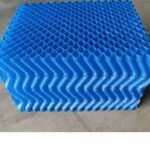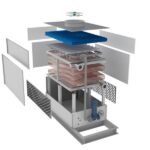Gearbox
Gearbox in a cooling tower is a mechanical component that serves to transmit and control the rotational speed and torque of the fan or other moving parts within the tower. It typically consists of gears enclosed in a housing, designed to efficiently transfer power from the motor to the fan shaft. Gearboxes in cooling towers play a crucial role in ensuring optimal fan operation, controlling the speed of rotation to achieve the desired airflow for effective heat dissipation. They are engineered to withstand the environmental conditions within cooling towers, including exposure to moisture, heat, and varying operational loads.

Gearbox in Cooling Towers
Application of
- Power Generation Plants: Both conventional and renewable energy plants use cooling towers with gearboxes to regulate fan speeds for effective cooling of equipment.
- HVAC Systems: Large-scale HVAC systems in commercial buildings, hospitals, data centers, and shopping malls often incorporate cooling towers with gearboxes for thermal management.
- Food and Beverage Processing: Facilities in the food and beverage industry use cooling towers with gearboxes to regulate temperatures during production processes.
- Oil and Gas Industry: Refineries and petrochemical plants employ cooling towers with gearboxes to cool equipment and processes involved in oil and gas production.
- Water Treatment Plants: Municipal water treatment facilities use cooling towers with gearboxes to control temperatures in water treatment.
Gearbox in Cooling Towers
Efficiency Benefits of
- Optimized Fan Speed: Gearboxes allow precise control over fan speeds, optimizing airflow for efficient heat dissipation.
- Energy Savings: By adjusting fan speeds to match cooling demands, gearboxes help reduce energy consumption compared to fixed-speed systems.
- Enhanced Cooling Performance: Efficient fan speed control ensures consistent and effective heat transfer, improving overall cooling tower performance.
- Extended Equipment Lifespan: Properly regulated fan speeds can prolong the lifespan of cooling tower components, reducing maintenance and replacement costs.
- Environmental Impact: Lower energy consumption contributes to reduced carbon footprint and environmental impact associated with cooling tower operations.
Other Cooling Tower Spares We Manufacture
Honeycomb PVC Fills
Honeycomb PVC Fills are a type of fill media used in cooling towers, made from polyvinyl chloride (PVC). They feature a honeycomb-like structure that maximizes the surface area

Drift Eliminators
Drift Eliminators are essential components in cooling towers designed to minimize the loss of water droplets, known as drift, that are carried out of the tower by the exiting airflow.

Axial Fan
Axial Fan is a type of fan that moves air along the axis of its blades. It typically consists of a motor and blades mounted on a shaft within a cylindrical housing. Axial fans are designed

Motors
Motors are specially designed electric motors used to drive fans in cooling towers. They are typically robust and corrosion-resistant, often made of materials like stainless steel

FRP Casing
FRP Casing refers to casings or enclosures made from Fiberglass Reinforced Plastic (FRP). FRP is a composite material consisting of a polymer matrix reinforced with fiberglass fibers.

Distribution Pipes
Distribution Pipes are essential components of infrastructure systems used to convey fluids from a central source to multiple endpoints for consumption or use.

Sprinkler
Sprinkler in cooling towers are mechanical devices designed to evenly distribute water over the fill media inside the tower. They play a crucial role in the cooling process

Nozzles
Nozzles in cooling towers are devices designed to distribute water evenly over the fill material inside the tower. They play a critical role in facilitating efficient heat transfer

Structure and Hardware
Structure and Hardware of a cooling tower encompass its physical framework and essential components designed to facilitate heat dissipation.

